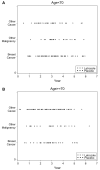Competing causes of death from a randomized trial of extended adjuvant endocrine therapy for breast cancer
- PMID: 18270335
- PMCID: PMC2745611
- DOI: 10.1093/jnci/djn014
Competing causes of death from a randomized trial of extended adjuvant endocrine therapy for breast cancer
Abstract
Background: Older women with early-stage breast cancer experience higher rates of non-breast cancer-related death. We examined factors associated with cause-specific death in a large cohort of breast cancer patients treated with extended adjuvant endocrine therapy.
Methods: In the MA.17 trial, conducted by the National Cancer Institute of Canada Clinical Trials Group, 5170 breast cancer patients (median age = 62 years; range = 32-94 years) who were disease free after approximately 5 years of adjuvant tamoxifen treatment were randomly assigned to treatment with letrozole (2583 women) or placebo (2587 women). The median follow-up was 3.9 years (range 0-7 years). We investigated the association of 11 baseline factors with the competing risks of death from breast cancer, other malignancies, and other causes. All statistical tests were two-sided likelihood ratio criterion tests.
Results: During follow-up, 256 deaths were reported (102 from breast cancer, 50 from other malignancies, 100 from other causes, and four from an unknown cause). Non-breast cancer deaths accounted for 60% of the 252 known deaths (72% for those > or = 70 years and 48% for those < 70 years). Two baseline factors were differentially associated with type of death: cardiovascular disease was associated with a statistically significant increased risk of death from other causes (P.002), and osteoporosis was associated with a statistically significant increased risk of death from other malignancies (P.05). An increased risk of breast cancer-specific death was associated with lymph node involvement (P < .001). Increased risk of death from all three causes was associated with older age (P < .001).
Conclusions: Non-breast cancer-related deaths were more common than breast cancer-specific deaths in this cohort of 5-year breast cancer survivors, especially among older women.
Figures

Comment in
-
Time to remove the subspecialty blinders: breast cancer does not exist in isolation.J Natl Cancer Inst. 2008 Feb 20;100(4):230-1. doi: 10.1093/jnci/djn015. Epub 2008 Feb 12. J Natl Cancer Inst. 2008. PMID: 18270334 No abstract available.
References
-
- Hudis CA, Barlow WE, Costantino JP, et al. Proposal for standardized definitions for efficacy end points in adjuvant breast cancer trials: the STEEP system. J Clin Oncol. 2007;25(15):2127–2132. - PubMed
-
- U.S. Department of Health and Human Services . Guidance for Industry Clinical Trial Endpoints for the Approval of Cancer Drugs and Biologics. U.S. Department of Health and Human Services, Food and Drug Administration Center for Drug Evaluation and Research Center for Biologics Evaluation and Research; 2007. http://www.fda.gov/cber/gdlns/clintrialend.pdf
-
- Early Breast Cancer Trialists’ Collaborative Group (EBCTCG) Effects of chemotherapy and hormonal therapy for early breast cancer on recurrence and 15-year survival: an overview of the randomized trials. Lancet. 2005;365:1687–1717. - PubMed
-
- Early Breast Cancer Trialists’ Collaborative Group (EBCTCG) Effects of radiotherapy and of differences in the extent of surgery for early breast cancer on local recurrence and 15-year survival: an overview of the randomized trials. Lancet. 2005;366:2087–2106. - PubMed
-
- Henderson IC, Patek AJ. The relationship between prognostic and predictive factors in the management of breast cancer. Breast Cancer Res Treat. 1998;52:261–288. - PubMed
Publication types
MeSH terms
Substances
Grants and funding
LinkOut - more resources
Full Text Sources
Other Literature Sources
Medical

